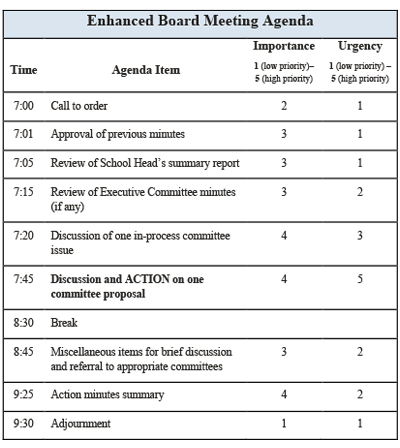A typical Board meeting at many schools is based on a standard format primarily structured around reports from the School Head and various committees. This type of meeting often fosters results that call for little or no action. When trapped in such routine agendas with no true focal points, many Board meetings simply “go through the motions.”
Board meetings need not be that way! A strategic Board can benefit from an “enhanced agenda” that focuses on significant issues and facilitates action on those targeted issues. This is possible when Board functions are based on the concept that most of the Board’s work is accomplished at committee level rather than by the full Board. Consider the suggested agenda below.

Note that this agenda specifies discussing only one in-process committee issue, taking action on only one proposal, and limiting the meeting to 2-1/2 hours. Although you may at times have more than two pressing matters to consider, sticking as closely as possible to these parameters helps ensure a productive, upbeat session. The purpose of this limited discussion is to allow a Committee Chair access to whole-Board feedback about some sticking point faced by that committee as it works toward finalization of its proposal.
This agenda specifies the key topics for each meeting, ranks all agenda items by urgency and importance on a scale of 1 (low priority) to 5 (high priority), and sets a time frame. The ranking, carried out by the Board President with the Head’s input, trains the Board to focus its energy on items that are both important and urgent.
The agenda should be sent to all Board members at least four days prior to the scheduled meeting. Include a packet that also provides a summary report of administrative activity prepared by the School Head, a digest of committee research or other relevant background for anticipated deliberation, and minutes of interim meetings (if any) of the Executive Committee.
For example, as the Finance Committee moves toward finalization of its proposed operations budget, it may wish to have face-to-face input by the whole Board on a particular expenditure under consideration prior to finalizing its draft budget. This kind of Board review of committee work is quite different in its purpose from the deadly habit of having every committee routinely summarize its activities, regardless of the nature and stage of development of those activities.
The following agenda item—discussion and action on the committee proposal—is shown in boldface and awarded a high rating on importance, urgency, or both, to emphasize to Board members that this is the primary reason for this meeting. Members, duly alerted, can then be expected to invest significant homework time in preparation. (This material is the “digest of committee research or other relevant background for anticipated deliberation” that is sent in advance with the agenda packet.)
At the close of the meeting, the appropriate Board officer reads the action minutes, the short list of items on which action has been taken or assigned. This would include consensus approval (or not) of the in-process committee activity discussed earlier in this meeting and the results of the whole-Board vote on the committee action proposal. Also include any referrals to committee or to a subsequent whole-Board meeting of any non-agenda items introduced in the “miscellaneous” discussion segment of the agenda.
Adopting an agenda that is enhanced in this manner keeps your strategic Board focused. For more on the importance of developing and maintaining a strategic Board, you may be interested in our Webinar, The Strategic Board: Laying the Foundation for Changed Lives.
Additional ISM resources:
ISM Monthly Update for Trustees Vol. 12 No. 2 Board Meetings: Expectations
ISM Monthly Update for Trustees Vol. 11 No. 7 Ten Essential Rules for Productive Meetings
ISM Monthly Update for Trustees Vol. 11 No. 3 Use Meeting Summaries to ‘Market’ Your Board
Additional ISM resources for Gold Consortium members:
I&P Vol. 37 No. 5 Chart the Attendance at Board and Committee Meetings
I&P Vol. 35 No. 5 The Board Policy Manual
I&P Vol. 28 No. 4 A Due Diligence Checklist for Board Trustees





